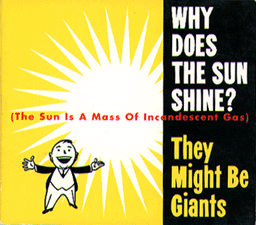Astronomy 162: Professor Barbara Ryden

The Sun is made of dense gas. The average density of the Sun is about 1400 kilograms per cubic meter, 40 percent greater than the density of water. The Sun remains gaseous (rather than liquid or solid) at these high densities because of its extraordinarily high temperature, which prevents the ions within the Sun from bonding together. The gas of which the Sun is made is mostly ionized hydrogen and ionized helium, the two simplest chemical elements. The Sun thus contains positively charged hydrogen nuclei, positively charged helium nuclei, and negatively charged electrons. Because photons scatter readily from free electrons, the Sun is opaque (you can't see through the Sun to see the stars behind it).
As you know from Astronomy 161, a hot, dense, opaque object (such as the Sun, or the filament of a light bulb) produces a continuous blackbody spectrum of light. The temperature at the Sun's surface is 5800 Kelvin; the Sun's blackbody spectrum thus peaks at a wavelength of 500 nanometers, in the visible range of the spectrum. [For a review of blackbody radiation, see chapter 5 of the textbook, or the relevant Astronomy 161 web page.] The luminosity of the Sun (that is, the amount of energy it radiates away per second in the form of light) is very large, thanks to the Sun's high temperature and large surface area. The total luminosity of the Sun is 3.9 x 1026 watts. (That is, 390 trillion trillion watts.)
What about chemical sources, such as the burning of
hydrogen? (We know there's plenty of hydrogen in the
Sun.) Burning one kilogram of hydrogen to form water,
by the reaction
2H + O -> H2O + energy,
releases 140 million joules of energy. (The `joule'
is the standard unit of energy in the metric system.
It is the energy required to keep a 1 watt light bulb
lit up for 1 second.
140 million joules is equivalent to 33,000 Calories
or 40 kilowatt-hours.)
If the Sun consisted entirely of hydrogen (which it doesn't),
and if you could find a source of oxygen with which to
burn it (never mind where all that oxygen would come from),
it could keep the Sun at its present luminosity for a mere
20,000 years.
A more potent energy source is needed to keep the Sun shining
for billions of years. What about nuclear fusion? Four hydrogen
nuclei can be fused together into a helium nucleus, accompanied
by the release of energy:
4H -> He + energy.
Fusing one kilogram of hydrogen into helium releases 630
trillion joules of energy. That's nearly 5 million
times what you'd get by burning the same hydrogen to get
water. Thus, fusion of hydrogen will keep the Sun shining
at a constant luminosity not for 20 thousand years, but for
as much as 100 billion years.
Albert Einstein provided us with an answer to
our questions. He pointed out that mass can
be converted into energy, and vice versa. The
`exchange rate' between mass and energy is given
by the famous equation
E = m c2
where E = energy, m = mass, and c = the speed of
light in a vacuum (300,000,000 ometers/second).
Thus, the total amount of MASS+ENERGY is conserved.
Every second, as we have seen, the Sun creates E = 3.9 x 1026 joules of energy. To balance the books, every second the Sun destroys m = E/c2 = 4.3 x 109 kilograms of mass. This mass loss, equivalent to more than 4 million tons per second, is accomplished by fusing 600 million tons of hydrogen into 596 million tons of helium.
It should be noted that fusion of atomic nuclei is difficult to initiate. Atomic nuclei are positively charged; thus each nucleus repels each other nucleus. In order to fuse two nuclei together, they must be brought very close together, so that the strong (but short-range) nuclear force that holds nuclei together can do its work. In order for two positively charged nuclei to overcome their electric repulsion and come very close, they have to collide at high speeds. High speeds for individual nuclei imply that the gas in which they exist is very hot (more than 10 million degrees Kelvin). These high temperatures are not found at the Sun's surface, but only in its hot, dense core.
Updated: 2003 Jan 7
Copyright © 2003, Barbara Ryden